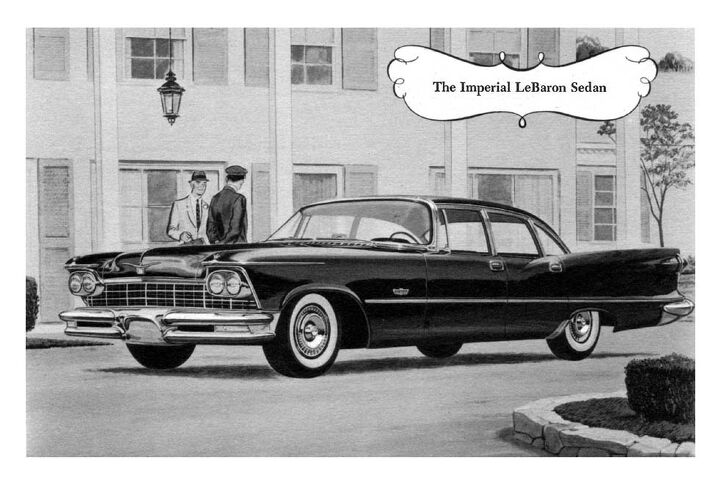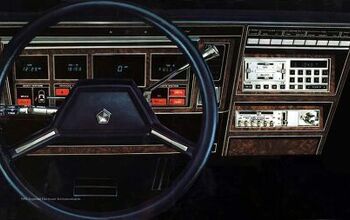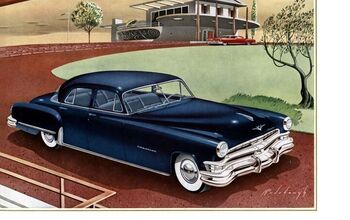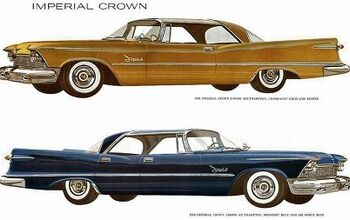Rare Rides Icons: The History of Imperial, More Than Just a Car (Part VII)

Today’s installment of the Imperial series is our seventh and coincides with the seventh generation Imperial. Officially it was the second-generation car under the new Imperial marque, an independent arm of Chrysler launched in 1955 to compete with the likes of Lincoln and Cadillac. The move to independence brought with it a resurgence of interest in the brand, as the Exner styled ’55 and ’56 Imperials stood out from the rest of Chrysler’s offerings visually, and in terms of quality and luxury. We pick up in 1957 when it was time for another new Imperial.
The Imperial launched in 1955 used the same platform as the New Yorker with a four-inch extension, but for 1957 Chrysler granted Imperial its own platform. With a 129-inch wheelbase, new Imperials had four fewer inches between the wheels than in 1956. Unnamed at the time, Chrysler would assign the D-body name to the platform in 1964. The platform was notable for its very sturdy body-on-frame construction, which persisted on Imperial while other Chrysler offerings moved to unibody construction from 1960 onward.
Overall length shrunk about five inches for 1957, at 224.4″ overall. However, Imperial was over two inches wider at 81.2 inches (78.8″ previously). Imperial was notably wider than other Chrysler cars: The New Yorker was 78.8 inches wide in 1957, and 219 inches long. Coming with width meant Imperial had more shoulder room than any other contemporary car, with 64 inches at the front, and 62 at the rear. It was the start of the lower, wider era, as 1956’s overall height of 61.5 inches dropped to 57.5 inches in 1957.
That year was also the start of some road-hugging weight for Imperial, as the previous generation’s hefty 4,800 or so pounds was the starting point for the 1957 Imperial. Depending on year and trim, weight ballooned up to 5,500 pounds. Suitably to cope with all that extra weight, the Imperial’s Hemi V8 was increased from its 354 cubic-inch (5.8L) to 392 cubic inches (6.4L). Dual exhaust was standard on all Imperials. The transmission was the same three-speed TorqueFlite A466 as the prior year.
Chrysler introduced a new suspension design on the ’57 Imperial, Torsion-Aire. A torsion bar design, the suspension helped reduce unsprung weight and moved the center of gravity lower, and toward the rear.
The rear suspension was multi-leaf, and the combination promised better handling and a smoother ride. It was an unusual setup, as typically a torsion bar setup would have coil springs at the rear. Chrysler’s torsion bar suspension was a first for a major American manufacturer, and Chrysler spread it across its entire lineup for 1957.
The generous suspension gifting was another first for cars in the lower and middle segments of the market. Packard implemented a complicated four-wheel torsion bar on its pricier models in 1955, but that was the torsion bar’s only other usage by a contemporary American manufacturer. Elsewhere on the advancement front, Chrysler used curved side glass in the Imperial – a first in an American production car.
Imperial wore all-new styling in 1957, as Virgil Exner debuted the “Forward Look.” Smaller single (or double) headlamps replaced the larger lamps of the prior year and rested within a more streamlined visage that saw finer use of chrome detailing and more of it. Cadillac would debut a front end similar to the ’57 Imperial in 1959. Worth an aside, only a select few of the ’57 Imperials received single headlamps, as it seems quad headlamps were not yet legal in all areas. Imperial advertised both headlamp types within its literature.
The rest of the new Imperial was more flashy and Fifties, and a bit less formal looking. For the first time, rear fender lines were completely flush with the Imperial’s body. Block lettering from the year before was replaced by large, flowery cursive “Imperial” script on fenders and at the rear. Tail lamps were now integrated into the much larger rear fins, which wore rocket-inspired trim detailing. Rocket details continued at the large chrome bumper with dual ovoid stamping. And in that most Fifties of tropes, the trunk lid had an optional simulated continental kit, painted in matching or contrasting color. Chrysler called it FliteSweep, and customers loved the look so much the option spread to lesser Chrysler vehicles afterward.
The newly modernized Imperial was built at Jefferson Avenue Assembly, as it had been before. 1957 saw the loss of a long-wheelbase Imperial, as all Chrysler-built cars were the same overall length. Imperials’ former C-series numbering system went by the wayside and was replaced by Series IMI-, in numbers 1, 2, or 4. Base models (IMI-1) started at $4,740 ($47,500 adj.), while IMI-2 was the Imperial Crown at $5,400 ($54,100 adj.) for a four-door. IMI-4 was the Imperial LeBaron and was priced at $5,740 ($57.500 adj.).
Two-door bodies were available in hardtop or convertible guises (convertible a first for a factory-made Imperial), and four doors were either sedan or hardtop. Hardtops had no pillars and were called Southampton regardless of the number of doors unless they were a LeBaron. Trims became more complicated without the long wheelbase: The Imperial Crown was no longer the aspirational top model as it had been for years, but one might still purchase an Imperial Crown Southampton as an upper-middle Imperial.
The flagship for 1957 was the Imperial LeBaron, which recalled the name of the coachbuilder that built it some decades before. Indeed the advertising for the Imperial LeBaron even referenced the “custom-built creations” one could no longer purchase, and stated the LeBaron would only be available in small numbers. Also built in very small numbers by Ghia was the ’57 Imperial Crown limousine. Strictly a custom-order vehicle, it was not advertised with the Imperial lineup. Imperial Crown used the 1958 grille in 1957, and 36 cars were sold at the shocking ask of $12,000, or over $120,000 adjusted. That’s a car worth covering separately.
Imperial’s sales soared as the all-new styling in the company’s third model year made other luxury cars look stodgy and dated. 1957 would be the best-ever year sales for any Imperial, at 37,593. Though it paled in comparison to the sales of more established luxury marques like Cadillac, Imperial made very quick inroads into the market. But it was not without cost, as the redesign was hastily done and quality control suffered over the superb finishing of the 1955-1956 models. The yet-named D-body was a long-lived one under the Imperial, so we’ll be back with more on its developments next time.
[Images: Imperial]

Interested in lots of cars and their various historical contexts. Started writing articles for TTAC in late 2016, when my first posts were QOTDs. From there I started a few new series like Rare Rides, Buy/Drive/Burn, Abandoned History, and most recently Rare Rides Icons. Operating from a home base in Cincinnati, Ohio, a relative auto journalist dead zone. Many of my articles are prompted by something I'll see on social media that sparks my interest and causes me to research. Finding articles and information from the early days of the internet and beyond that covers the little details lost to time: trim packages, color and wheel choices, interior fabrics. Beyond those, I'm fascinated by automotive industry experiments, both failures and successes. Lately I've taken an interest in AI, and generating "what if" type images for car models long dead. Reincarnating a modern Toyota Paseo, Lincoln Mark IX, or Isuzu Trooper through a text prompt is fun. Fun to post them on Twitter too, and watch people overreact. To that end, the social media I use most is Twitter, @CoreyLewis86. I also contribute pieces for Forbes Wheels and Forbes Home.
More by Corey Lewis
Latest Car Reviews
Read moreLatest Product Reviews
Read moreRecent Comments
- Bob Hey Tassos, have you seen it with top down. It's a permanent roll bar so if it flips no problem. It's the only car with one permanently there. So shoots down your issue. I had a 1998 for 10 years it was perfect, but yes slow. Hardly ever see any of them anymore.
- 3-On-The-Tree 2007 Toyota Sienna bedsides new plugs, flat tire on I-10 in van Horn Tx on the way to Fort Huachuca.2021 Tundra Crewmax no issues2021 Rav 4 no issues2010 Corolla I put in a alternator in Mar1985 Toyota Land Cruiser FJ60 280,000mi I put in a new radiator back in 08 before I deployed, did a valve job, new fuel and oil pump. Leaky rear main seal, transmission, transfer case. Rebuild carb twice, had a recall on the gas tank surprisingly in 2010 at 25 years later.2014 Ford F159 Ecoboost 3.5L by 80,000mi went through both turbos, driver side leaking, passenger side completely replaced. Rear min seal leak once at 50,000 second at 80,000. And last was a timing chain cover leak.2009 C6 Corvette LS3 Base, I put in a new radiator in 2021.
- ChristianWimmer 2018 Mercedes A250 AMG Line (W177) - no issues or unscheduled dealer visits. Regular maintenance at the dealer once a year costs between 400,- Euros (standard service) to 1200,- Euros (major service, new spark plugs, brake pads + TÜV). Had one recall where they had to fix an A/C hose which might become loose. Great car and fun to drive and very economical but also fast. Recently gave it an “Italian tune up” on the Autobahn.
- Bd2 Lexus is just a higher trim package Toyota. ^^
- Tassos ONLY consider CIvics or Corollas, in their segment. NO DAMNED Hyundais, Kias, Nissans or esp Mitsus. Not even a Pretend-BMW Mazda. They may look cute but they SUCK.I always recommend Corollas to friends of mine who are not auto enthusiasts, even tho I never owed one, and owned a Civic Hatch 5 speed 1992 for 25 years. MANY follow my advice and are VERY happy. ALmost all are women.friends who believe they are auto enthusiasts would not listen to me anyway, and would never buy a Toyota. They are damned fools, on both counts.











































Comments
Join the conversation
I enjoyed the one finger steering as well.
It is my understanding, that Elvis drove a 1957 Imperial in one of his first movies---and that it had a movable front headlight, like a spot lamp!!! this was only available in 1957, when it still had single headlamps on each side. has anyone else heard that??Thanks!